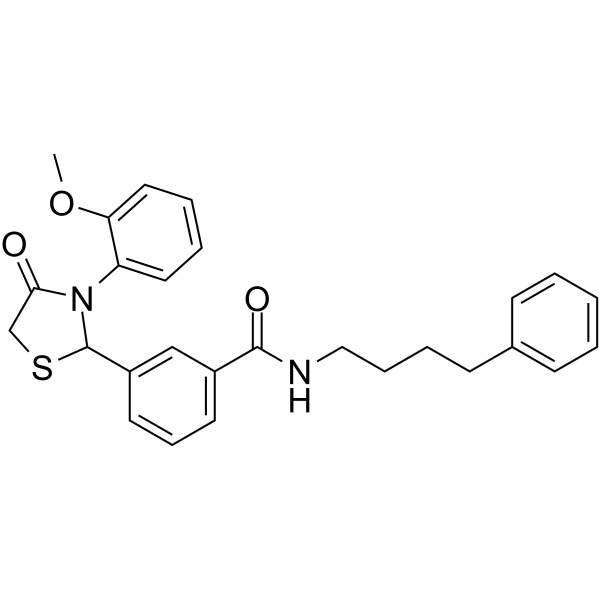
WJ460
CAS No. 1415251-36-3
WJ460( —— )
Catalog No. M26864 CAS No. 1415251-36-3
WJ460 is an effective inhibitor of myoferlin. WJ460 exerts anti-metastatic activity in breast cancer cells.
Purity : >98% (HPLC)
 COA
COA
 Datasheet
Datasheet
 HNMR
HNMR
 HPLC
HPLC
 MSDS
MSDS
 Handing Instructions
Handing Instructions
| Size | Price / USD | Stock | Quantity |
| 5MG | 129 | Get Quote |


|
| 10MG | 219 | Get Quote |


|
| 25MG | 357 | Get Quote |


|
| 50MG | 537 | Get Quote |


|
| 100MG | 781 | Get Quote |


|
| 500MG | 1593 | Get Quote |


|
| 1G | Get Quote | Get Quote |


|
Biological Information
-
Product NameWJ460
-
NoteResearch use only, not for human use.
-
Brief DescriptionWJ460 is an effective inhibitor of myoferlin. WJ460 exerts anti-metastatic activity in breast cancer cells.
-
DescriptionWJ460 is an effective inhibitor of myoferlin. WJ460 exerts anti-metastatic activity in breast cancer cells.(In Vitro):WJ460 dose-dependently blocks breast cancer cell invasion through Collagen I(IC50: 43.37 nM in MDA-MB-231 and 36.40 nM in BT549 cells).(In Vivo):In a spontaneous metastasis model, WJ460 inhibits angiogenesis, breast tumor growth, and spontaneous metastasis .
-
In Vitro——
-
In Vivo——
-
Synonyms——
-
PathwayOthers
-
TargetOther Targets
-
RecptorAdrenocorticotropic hormone (ACTH)
-
Research Area——
-
Indication——
Chemical Information
-
CAS Number1415251-36-3
-
Formula Weight460.59
-
Molecular FormulaC27H28N2O3S
-
Purity>98% (HPLC)
-
Solubility——
-
SMILESO=C(NCCCCC=1C=CC=CC1)C2=CC=CC(=C2)C3SCC(=O)N3C=4C=CC=CC4OC
-
Chemical Name——
Shipping & Storage Information
-
Storage(-20℃)
-
ShippingWith Ice Pack
-
Stability≥ 2 years
Reference
1.Francesco Iuliano, et al. Adding Slow Release Tetracosactide Acetate to Eltrombopag Improves Haematological Response in ITP Patients with Platelet-Count Fluctuation.
molnova catalog



related products
-
ML179
ML179 is a potent and selective inverse agonist of liver receptor homolog-1 (LRH1, NR5A2) with IC50 of 320 nM.
-
Lats-IN-1
Lats-IN-1 is a potent and ATP-competitive Lats1 and Lats2 kinases inhibitor. It promotes Yap-dependent proliferation in postmitotic mammalian tissues.
-
CGRP (83-119), rat T...
Calcitonin Gene Related Peptide (CGRP) (83-119), rat (TFA) is a 37 amino acid calcitonin family of neuropeptide, acts through calcitonin receptor-like receptor.



 Cart
Cart
 sales@molnova.com
sales@molnova.com


